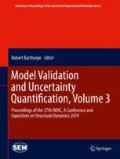Abstract
Different mathematical models can be developed to represent the dynamic behavior of structural systems and assess properties, such as risk of failure and reliability. Selecting an adequate model requires choosing a model of sufficient complexity to accurately capture the output responses under various operational conditions. However, as model complexity increases, the functional relationship between input parameters varies and the number of parameters required to represent the physical system increases, reducing computational efficiency and increasing modeling difficulty. The process of model selection is further exacerbated by uncertainty introduced from input parameters, noise in experimental measurements, numerical solutions, and model form. The purpose of this research is to evaluate the acceptable level of uncertainty that can be present within numerical models, while reliably capturing the fundamental physics of a subject system. However, before uncertainty quantification can be performed, a sensitivity analysis study is required to prevent numerical ill-conditioning from parameters that contribute insignificant variability to the output response features of interest. The main focus of this paper, therefore, is to employ sensitivity analysis tools on models to remove low sensitivity parameters from the calibration space. The subject system in this study is a modular spring-damper system integrated into a space truss structure. Six different cases of increasing complexity are derived from a mathematical model designed from a two-degree of freedom (2DOF) mass spring-damper that neglects single truss properties, such as geometry and truss member material properties. Model sensitivity analysis is performed using the Analysis of Variation (ANOVA) and the Coefficient of Determination R 2. The global sensitivity results for the parameters in each 2DOF case are determined from the R 2 calculation and compared in performance to evaluate levels of parameter contribution. Parameters with a weighted R 2 value less than .02 account for less than 2% of the variation in the output responses and are removed from the calibration space. This paper concludes with an outlook on implementing Bayesian inference methodologies, delayed-acceptance single-component adaptive Metropolis (DA-SCAM) algorithm and Gaussian Process Models for Simulation Analysis (GPM/SA), to select the most representative mathematical model and set of input parameters that best characterize the system’s dynamic behavior.
Access this chapter
Tax calculation will be finalised at checkout
Purchases are for personal use only
References
Farajpour, I., Atamturktur, S.: Error and uncertainty analysis of inexact and imprecise computer models. J. Comput. Civ. Eng. 27, 407–418 (2013)
Roy, C.J., Oberkampf, W.L.: A comprehensive framework for verification, validation, and uncertainty quantification in scientific computing. Comput. Methods Appl. Mech. Eng. 200, 2131–2144 (2011)
Atamturktur, S., Hemez, F.M., Laman, J.A.: Uncertainty quantification in model verification and validation as applied to large scale historic masonry monuments. Eng. Struct. 43, 221–234 (2012)
Mallapur, S., Platz, R.: Quantification and evaluation of uncertainty in the mathematical modelling of a suspension strut using Bayesian model validation approach. In: Conference Proceedings of the Society for Experimental Mechanics Series, vol. 3, pp. 113–124 (2017)
Chopra, A.K.: Dynamics of Structures, Technical Report, Pearson/Prentice-Hall, Upper Saddle River (2012)
Barnard, G.A.: New methods of quality control. J. R. Stat. Soc. 126, 255–258 (1963)
Zhang, R., Mahadevan, S.: Model uncertainty and Bayesian updating in reliability-based inspection. Struct. Saf. 22, 145–160 (2000)
Eck, V.G., Donders, W.P., Sturdy, J., Feinberg, J., Delhaas, T., Hellevik, L.R., Huberts, W.: A guide to uncertainty quantification and sensitivity analysis for cardiovascular applications. Int. J. Numer. Methods Biomed. Eng. 32, e02755 (2016)
Mallapur, S., Platz, R.: Uncertainty quantification in the mathematical modelling of a suspension strut using bayesian inference. Mech. Syst. Signal Process. 118, 158–170 (2019)
ContiTech: Schwingmetall die original gummi-metall- verbindung 28–29 (2011)
Czop, P., Gniłka, J.: Reducing aeration and cavitation effect in shock absorbers using fluid-structure interaction simulation, Technical Report (2016)
Duym, S.W., Stiens, R., Baron, G.V., Reybrouck, K.G.: Physical modeling of the hysteretic behaviour of automotive shock absorbers, Technical Report, SAE Technical Paper (1997)
Christen, J., Fox, C.: Markov chain Monte Carlo using an approximation. J. Comput. Graph. Stat. 14, 795–810 (2005)
Fox, C., Nicholls, G.: Sampling conductivity images via MCMC, Technical Report, University of Leeds (1997)
Haario, H., Saksman, E., Tamminen, J.: Component wise adaptation for high dimensional MCMC. Comput. Stat. 20, 265–273 (2005)
Higdon, D., Gattiker, J., Williams, B., Rightley, M.: Computer model calibration using high-dimensional output. J. Am. Stat. Assoc. 103, 570–583 (2008)
Gattiker, J.R.: Using the Gaussian process model for simulation analysis (GPM/SA) code, Technical Report, Los Alamos National Laboratory (2005)
Kennedy, M.C., O’Hagan, A.: Bayesian calibration of computer models. J. R. Stat. Soc. Ser. B Stat. Methodol. 63, 425–464 (2001)
Acknowledgements
The authors gratefully acknowledge the support of the National Science Foundation under grant #1633608, and the German Research Foundation (DFG) SFB 805 project grant for funding this research. In particular, the authors acknowledge Maximilian Schäffner and Robert Feldmann for their assistance during this project.
Author information
Authors and Affiliations
Corresponding author
Editor information
Editors and Affiliations
Rights and permissions
Copyright information
© 2020 Society for Experimental Mechanics, Inc.
About this paper
Cite this paper
Locke, R., Kupis, S., Gehb, C.M., Platz, R., Atamturktur, S. (2020). Applying Uncertainty Quantification to Structural Systems: Parameter Reduction for Evaluating Model Complexity. In: Barthorpe, R. (eds) Model Validation and Uncertainty Quantification, Volume 3. Conference Proceedings of the Society for Experimental Mechanics Series. Springer, Cham. https://doi.org/10.1007/978-3-030-12075-7_28
Download citation
DOI: https://doi.org/10.1007/978-3-030-12075-7_28
Published:
Publisher Name: Springer, Cham
Print ISBN: 978-3-030-12074-0
Online ISBN: 978-3-030-12075-7
eBook Packages: EngineeringEngineering (R0)

